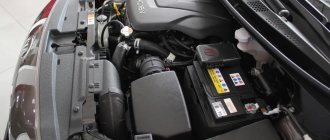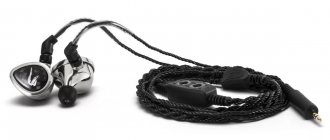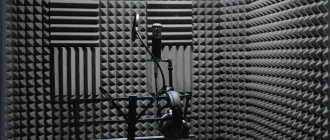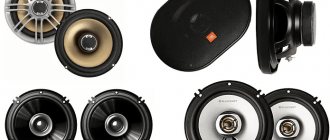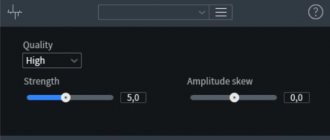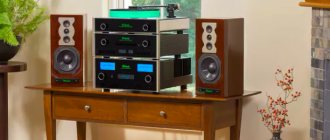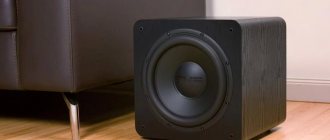Home page
All about TVs
Editor
Any user, if he is no longer satisfied with the sound of the television programs he is watching, thinks about changing the audio system (media system). And if the majority of viewers are content with a more modern model, then there are those who never have enough and constantly want even better. Such people are not satisfied with mass-produced devices. What should we call them? Are they aesthetes or pragmatists? Let's try to figure it out, starting with the most expensive audio system models.
Kipnis' Outer Limits Theater
The exorbitant cost of this home (!) cinema by the manufacturers is explained by the fact that the 8.8-channel KSS audio system is improved by Snell subwoofers. They are housed together with the highest quality components in excellent quality cases. Not even any large cinema can afford such an acquisition. It’s hard to even imagine how your favorite blockbuster will look at the Kipnis Theater, which goes beyond imagination. Cost: $6,000,000.
Goldmund Apologue Anniversary
A limited edition of these speakers was released in honor of the 25th anniversary of their predecessors, who saw the world in 1987. The design remains the same, but the technical parameters reflect all the experience accumulated by the company during this period.
The signal is transmitted via wi-fi, so no cable is required. The exception is the AC jack, which can be optionally installed under the speaker.
Externally, the system consists of 5 metal blocks of different sizes, fixed by a black frame with reliable fastenings. The height of the structure is 2 m. The system has 2 speakers with a diameter of 31 cm. The parameters are adjusted individually. The total power of the system is 3.6 kW. In addition to wireless communication, the package includes a preamplifier and Proteus correction.
The cost of Goldmund Apologue Anniversary is $550,000.
Backes Muller BM 100
The unusual shape of this audio system is explained by the introduction of technology that allows the system to draw an ideal boundary between high, mid and low tones. It could well be mistaken for elaborate furniture that belongs in the bedroom of a beautiful woman. As its creators assure, the system is capable of filling a room of almost any size with sound. And he will choose the most optimal option. Cost $500,000.
Tidal La Assoluta
This 4-way speaker system is a three-unit design. Its uniqueness is ensured by midrange/bass drivers having a diamond diaphragm and a diameter of 135 mm. The speakers are designed by Tidal and can only be used by Tidal.
For the speakers, a special polished panel was mounted, for which stainless steel was used. Each membrane weighs 13.5 carats.
La Assoluta has impressive dimensions - 2.32 m high, 0.38 m wide and 0.65 m deep. Each column weighs 485 kg.
The package includes 4 passive radiators. Their diaphragm travel is increased. The phase-frequency response is absolutely consistent thanks to the Assoluta-Unopulse crossover with silver components.
The cost of Tidal La Assoluta is more than $640,000.
California Audio Technology (CAT) MBX
The manufacturer of the presented audio system became famous thanks to projects that are striking in their grandeur. The most impressive examples produced by SAT use hundreds of subwoofers alone, and moreover, more than a dozen channels. Wealthy connoisseurs are willing to pay more than one million dollars for such monsters. But among them there is also an option suitable for home use, for which you will have to pay only $500,000.
Zellaton Statement
This floorstanding speaker system is 3-way. It features a full cone tweeter, a full mid-cone cone and a woofer. Frequency range – from 20 Hz to 40 kHz. Additional amplification – up to 50 W. The sensitivity of the system is 92 dB.
The system weighs 300 kg. The dimensions are impressive - 1.8 m high, 0.6 m wide and 0.9 m deep.
The Zellaton Statement costs approximately $350,000.
Peak Consult Dragon Legend MKII
peak consult dragon legend mkii
The new one occupies a popular place in the lineup at a price of 260 thousand dollars. It has a passive sensing, frequency range from 5 to 45,000 Hz, which has an impact of 5 ohms, sensitively sensing 94 dB. The acoustic scope of the Dragon Legend turned out to be a new generation of Dragon.
The predecessor worked for 10 years as a flagship among other sound devices. The modern version has 2 thirteen-inch speakers with low frequency. Diffuser accompaniment in the form of a “sandwich” provides the desired improved effect. There are 2 six-inch midrange speakers, 1-inch high frequency. The included silk dome is used. With audiophile resistor capacitors, a breakthrough in sound perception occurs. Component manufacturing took place at our own production base, which allows us to be as confident as possible in the advantages of the system. The broken body part is made in black and has wood inserts. This is handmade multi-layer fiberboard as a gift.
The best cabinet speakers for transport
Box speakers are often waterproof, equipped with additional features (such as Wi-Fi support) and can be used not only in cars, but also in motorcycles, scooters and even watercraft.
Boss MC650B
5.0
★★★★★
editorial assessment
100%
buyers recommend this product
The Boss MC650B waterproof audio system is designed for use on motorcycles, scooters, and watercraft.
The acoustic set includes 4 speakers with a stylish grille and a multifunctional remote control controller. The cost of the kit is about 20 thousand rubles.
Advantages:
- Bluetooth module;
- waterproof PU with handlebar mount;
- AUX audio input 3.5 mm;
- amplifier with a peak power of 1200 W.
Flaws:
- high price.
Thanks to Bluetooth support, the Boss MC650B model allows you to transmit sound wirelessly, thereby ensuring the safety of your smartphone or player in difficult conditions.
ACV MRT61G
4.9
★★★★★
editorial assessment
95%
buyers recommend this product
The ACV MRT61G acoustic system is waterproof, making it suitable for use on watercraft.
The nominal power of the speakers is 100 W, the maximum is 200 W. The average cost of speakers is almost 10 thousand rubles.
Advantages:
- polypropylene diffuser with rubber suspension;
- titanium dome directional tweeter;
- ease of installation;
- high-quality assembly;
- complete moisture protection.
Flaws:
- limited scope.
ACV MRT61G speakers reproduce audio in the range of 65-20000 Hz, have a sensitivity of 90 dB and an impedance of 4 Ohms.
Wilson Audio WAMM Master Chronosonic – $850,000
WAMM stands for Wilson Audio Modular Monitor - and, as you might have guessed, Master Chronosonic speakers are made up of several modules. Their synchronization can be adjusted in steps of five microseconds. Precisely position the speakers according to your listening position and, according to Wilson Audio, the result will be much more realistic sound.
Measuring over 210 centimeters in height, each speaker's cabinet is crafted from aerospace-grade aluminum, and the open speaker architecture is designed to minimize stored energy. Each pair takes about 10 weeks to make, so it's no surprise that Wilson Audio only produces 70 pairs per year. Looking for something more affordable? Try Chronosonic XVX for 330 thousand.
Avalon Tesseract
Avalon tesseract
Known for 965 thousand dollars will allow you to listen to music in the passive range with a frequency from 16 to 70,000 Hz, while providing a favorable sound effect with a resistance of 6 ohms. A sensitivity of 93.5 dB occurs. The new Avalon Tesseract is an acoustic non-standard mode applied to a non-classical type. The shape of the pyramid allows you to see the perfect backdrop for any major event in its broken edges. Great design brings the developers' ideas to life.
Effective characteristics allow you to listen to sound with maximum comfort. The emitters of the device with a high-frequency speaker, the coating of which is made of diamond-coated Diamond Underhung technology, belong to the Voice-Coil line. Is the listener's dream come true. Dimensions are 0.78 inches, 4.5 inches of ceramic radiation comes from the midrange. 11 inches of midrange/bass dynamics are used. These are 4 eleven-inch frequencies with a reduced interval. The selection of drivers was done manually by the developers, checking with a multi-stage check that revealed any deviations. The engineers worked hard to achieve the best sound.
Avalon was able to improve audio equipment, making the process simple and unprecedented. Acoustic options can be purchased based on individual customer solutions using the developer’s diagrams. These are the company's design proposals to maintain quality and improve sound levels. The sketch is checked and finalized by professionals. Payment for the product becomes the last step in agreeing on the terms. The work of specialists is paid.
Magico Ultimate III – $600,000
For a pair of Magico Ultimate III they ask for 600 thousand dollars, and five-way systems with horn design are hidden in aluminum cases with a height of 230 centimeters. They reportedly require 10 amplifiers, and in terms of technical innovation, it's worth noting that each horn houses a high-sensitivity compression driver at the throat.
In addition to the CNC-milled horns, each speaker is equipped with six ALE compression drivers and four custom mid/bass and low-frequency drivers, the signal for which is prepared by an active crossover with DSP control. They weigh approximately half a ton each and take 18 months to complete. Please consider both of these factors when placing your order.
Genesis Prime
This is the latest addition to the company's flagship loudspeaker system, reflecting the company's decades of experience. Dynamic range is virtually unlimited, as is frequency response and soundstage performance.
The system is represented by 4 towers. The bass amplifier is servo controlled. There are only 6 channels per side, the power of each is 1 kW. Weight on each side is 545 kg.
The frequency range is from 16 Hz to 40 kHz. System sensitivity – 91 dB.
The cost of Genesis Prime is $300,000.
6. Piega Master Line Source Model
piega master line source
Sold for 250 thousand US dollars. This is a passive perception, at an audio frequency in the region from 6 to 54,000 Hz from the general system. With an impedance of 4 ohms and a sensitive component of 94 dB, the speakers allow you to get the most out of your sound. In the three-way dipole of the Swiss brand of speakers there are 39 speakers in the column. This is 24 tape high frequency potential LDR 2642 Mk2. Of these, 50% are located on the front panel, the others are located at the rear of the structure. The influence of 9 midrange dynamic elements, grade MLC 110-100, is used. Also used are 6 MOM-type LF speakers for operation.
The manufacturer, represented by the company's engineers, participated in the development of the design features of the model with radiation of the spectral frequency part at one wavelength. The cabinet element has an angular design look, the rigor gives neatness and modernity. Multi-layer panel rows complete the design. The exterior uses an aluminum composition and maintains the classic metallic style of silver material.
Kharma Grand Enigma – $1,000,000
The Dutch high-end audio manufacturer's Exquisite Extreme Grand Limited Edition 25 may seem quite expensive with a list price of £318k per pair, but the Grand Enigma aims higher. Worked only once, the system is rumored to have been created in a huge cellar in Belgium, and its price in dollars ends with six zeros.
For this reason, there is no other information about her; From the moment this photo was taken, it continues to be shrouded in secrecy.
German Physics THE GAUDI MK 2
Speaker system with 4 unique DDD drivers arranged linearly. The wide range provides very accurate and realistic reproduction by eliminating phase and level fluctuations at the mid-frequency crossover point.
There are 8 mid-bass drivers of 6 inches and 4 low-frequency drivers of 12 inches. The frequency range is from 15 Hz to 21.5 kHz. Each channel requires a 40 W power amplifier. Speaker sensitivity is 88.6 dB.
The system weighs 720 kg. The dimensions of the speakers are impressive - 2.1 m high, 1.3 m wide and almost 1 meter deep.
The cost of German Physiks THE GAUDI MK 2 is $320,000.
How to choose Hi-Fi acoustics
Location
It is important to understand where your speaker system will be placed. There are currently two main types that dominate the market: floor-standing and bookshelf speakers.
Bookshelf speakers tend to be more compact and don't have as much space in the cabinet, so they usually have fairly modest power output and less bass. Contrary to the name, it is better, of course, to place shelf holders on racks, although this is not necessary. They may often not be able to provide sound to a large room and are inferior in scale to floor-standing ones, but they provide deep, detailed sound, where you can make out more of the small nuances of the recording. Floor-standing acoustics have a larger body, there is room for low frequencies to develop, you can install larger drivers and more bands. They are usually more powerful, produce more spacious sound, and require more attention to the installation site, but the result is worth it.
Of course, this is only an average description; there are large, powerful bookshelf speakers with fat bass, and modest floorstanders for small rooms.
Type
There are also two of them: active and passive speakers.
The active type requires the presence of an amplifier inside the speaker. That is, they can play out of the box, just connect the signal source and go! This type also has disadvantages. Firstly, you deprive yourself of the opportunity to choose an amplifier, but they are different, and sound different, and how much space there is for an upgrade. Secondly, due to the fact that engineers need to place both the speakers and all the electronics in one case, the quality may suffer - you can’t really swing it. Therefore, such acoustics will either sound rather mediocre, or it will be something very expensive and sophisticated.
With a passive speaker system you will have to tinker more. This already requires some involvement from the user, but that’s why you want to plunge into the world of hi-fi? You will need to buy an external amplifier, which still needs to be chosen correctly. But there are so many opportunities for modernization here! You can select the components of your audio system based on your musical preferences.
Room
Of course, the room in which it will be located plays an important role in choosing an acoustic system. You shouldn’t buy huge floor-standing speakers for a tiny room, just as you shouldn’t hope that small bookshelf monitors will fill a huge room with sound. It is important to consider not only the size of the room, but also the availability of free space, so that it is possible to correctly position the acoustics. It should be borne in mind that if the speakers have a bass reflex located at the back, then they cannot be placed close to the wall, and if it is enough to place compact speakers at least ten centimeters from the wall, then for floor-standing acoustics up to one meter may be needed. Otherwise, you will either have an indistinct drone instead of bass, or you will have to plug the bass reflex holes, which will negatively affect the sound as a whole. It is important to ensure the optimal distance from the speaker system to the listener, as well as sufficient stereo width. In general, the rule is that the larger and more powerful the speakers, the more problems there are with their location in the room, and the greater the role the acoustic preparation of the room plays in shaping the sound of the speakers. It is impossible to fully cover the topic within the framework of this material, so let’s hope that you can find additional information on your own on the Internet.
Acoustic design
There are quite a few types of acoustic design, but the two most popular are bass reflex and closed. In a nutshell, an audio signal is also generated on the back side of the diffuser, and it is in antiphase to the main signal, therefore, it is important for engineers to decide what to do with this signal, since audio signals that are out of phase will interfere with each other. The first solution to the problem is a closed box. This means that the body of the speaker system is sealed, that is, its internal volume does not communicate in any way with the external environment, and vibrations of the rear side of the diffuser are simply damped. This design method is good because of its ease of implementation, but the disadvantages include the fact that in order to oscillate, the speaker will need to spend more energy, which means, all other things being equal, closed-type speakers will sound quieter. The most common type of acoustic design is bass reflex. This means that the internal volume of the speaker body communicates with the external environment through a special pipe, designed in such a way that the phases of sound waves from the front and rear sides of the diffuser add up, amplifying the sound. This effect manifests itself in a small frequency range. Simply put, the presence of a bass reflex gives a noticeable increase in low frequencies. Other acoustic design options are much less common and very specific.
Number of bands and frequency range
Dividing the entire range into separate bands is initially a sound idea, because speakers of different designs cope better with different frequencies. Making an acoustic system with one broadband speaker is difficult and expensive, so as a rule they have two or three speakers, where each is responsible for its own section, this allows you to get a more even frequency response (amplitude-frequency response), that is, there will be fewer dips and distortion in the reproduced frequency range.
This is not the most ideal solution, because a crossover is also added to the speaker design - a device that divides the signal into frequency bands, which also needs to be properly implemented. And here, too, there are intractable questions. The main thing is that it is very difficult to ensure an even frequency response in the area of separation of bands; as a rule, a dip forms in this place, and in the case of a two-way speaker, it is located in the region of 1-2 kHz - the area to which the human ear is most sensitive. In a three-way speaker system, the separation of the bands occurs in less critical areas, which makes this design somewhat more advanced. However, before purchasing a new speaker system, it is always advisable to familiarize yourself with the frequency response graph; fortunately, they are easy to find in the public domain.
Power, sensitivity, resistance
In principle, there is no need to delve into these numbers in detail. You just need to make sure that the selected speaker system matches your amplifier in terms of power and resistance (impedance). It is better to avoid strong distortions, that is, do not buy wildly powerful speakers for a weak amplifier (they simply will not swing and the sound will not open up), and, conversely, otherwise there is a high chance of the speakers failing.
The sensitivity of a speaker determines the sound pressure it creates, showing how loud (in dB) a 1W signal applied to the input will sound at a distance of 1m from the speaker. For systems of comparable power, the higher the sensitivity, the louder the sound. In terms of power, we can give the following very conditional advice: For small rooms (10-15 sq.m.), it is better to consider acoustics with a power of up to 50 watts. For medium-sized rooms (20-40 sq.m.), you can consider a power of 50-100 watts; for larger rooms, it is even better to consider options with a power of more than 100 watts.
Listen
The most important parameter by which you need to choose a speaker system is that you like its sound, so that it fully meets your ideas of what it should be. Of course, you should not be lazy and go to the store to listen to several different options. It is advisable to listen to records in the store that you are already familiar with, so that you know how they should sound correctly. In the end, you should listen to this system in the future, and not those who recommended it.
Speakers aren't everything
Yes, a home audio system is made up of many components, and speakers are only one of them. Therefore, you will need to strain once in order to choose and coordinate everything correctly. Don’t be lazy to study the topic a little, read useful literature, watch videos with lectures by smart people (fortunately, there are many of them in the public domain), don’t be shy to ask more advanced comrades, ask questions on specialized forums. Once you do this, you will get a simply luxurious system that will bring pleasure directly to your ears for many years.
